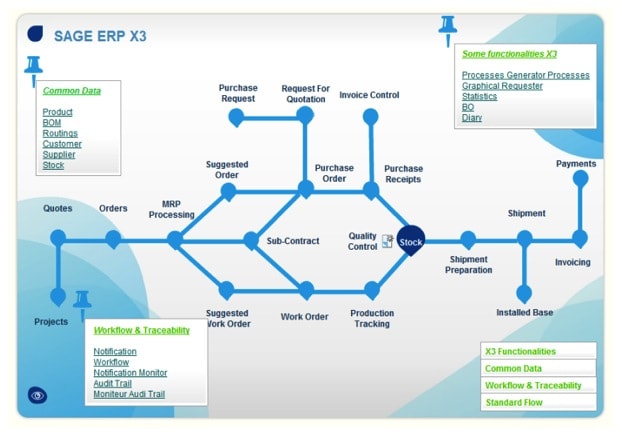Manufacturing Software: Sage X3 vs Sage PFW
When Sage announced the retirement of Sage PFW (to be completed on March 2014), companies that have used Sage PFW as their manufacturing software had to decide on a new solution to upgrade to. The process of adopting a new manufacturing software solution, more precisely a process manufacturing ERP software, is one that involves changes throughout the organization.
After nearly a year since the announcement, The Answer Company has helped numerous companies migrate from Sage PFW to new solutions. We have seen a lot of companies that primarily run manufacturing operations solidify significant benefits by moving to Sage X3.
The Differences Between Sage PFW and Sage X3 for Manufacturing
As we mentioned in our previous blogs on the Distribution, Finance, and Technology benefits, the differences between Sage PFW and Sage X3 are immense. Sage X3 is a web-based solution that can be deployed in over 70 countries around the globe, in 10 languages, making coordinating manufacturing across the board a possibility.
Sage X3 comes with built-in modules, workflows, and dashboards. It tracks manufacturing activities and transactions in real-time from multiple business units, keeping all information together but sortable, easily accessed and presented, and compared to Sage PFW, it’s very intuitive and easy to use.
This is especially true for industries that have traditionally relied heavily on Sage PFW, like manufacturing, distribution, wholesale, or services. For these companies we have found Sage X3 to be the ideal destination system.
Material Resource Planning (MRP) Included in Sage X3
Sage X3 enables manufacturing planning in multiple sites of the organization and its Material Resource Planning (MRP) includes scheduling functionality with a graphical drag-and-drop user interface. This makes life easier for managers and employees as they can visualize the production process from start to finish.
The decision-making tools for material planners include MPS charts, MRP schedules and a planner’s workbench – a significant improvement from PFW’s way of handling manufacturing. The MRP workbench also goes one step further, allowing for drill down to sources of supply and demand.
Connecting the Factory Floor with the Rest of the Organization
The new ERP solution also connects the factory floor and front lines of manufacturing with the rest of the organization. When we implemented Sage X3 at Garden Protein, a food manufacturer in British Columbia, we set up radio frequency hand held devices to communicate in real time with Sage X3. The objective was to gain speed and accuracy in checkpoints along the manufacturing cycle, to ensure production was running smoothly.
Additional improvements in manufacturing companies get when they move from Sage PFW to X3 include:
- X3 supports finite and infinite capacity requirements planning
- Ability to “reopen” a closed production order.
- X3 supports work center, routing for detail labour, machine and overhead planning, and cost analysis.
- Standard cost history is available for comparison of previous time periods to current.
- Can choose continuous process manufacturing.
- Work orders can be tied to a project for project control and reporting
- Electronic signatures are available for compliance with CFR21-11
- System supports bar code data collection for all material movement transactions, labour, and machine time out of the box.
The improvements listed are just a few of the reasons why Sage X3 is a definite upgrade for any manufacturing company that has grown accustomed to Sage PFW. Companies can expect to see improvements across operations, particularly in quality of user interaction and technology, as well as in financial, and distribution functionality.
Sage is still offering considerable financial incentives for companies still using Sage PFW to migrate to X3, so if you are still on the fence, this might be the right time to pull the trigger.

